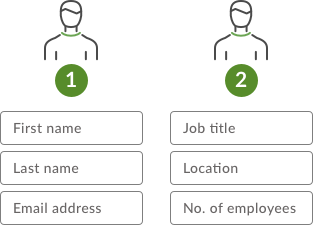
Unless you’re also the kind of person who enjoys speaking to telemarketers, chances are you hate filling out forms, responding to surveys or giving up more information about yourself than you feel is necessary—and who can blame you?
Today, we’re all constantly harassed by marketing through our phones, email addresses and television sets—and the majority of the marketing isn't even relevant. However, this leaves us at a bit of an impasse. As any good digital marketer knows, in order to receive more relevant marketing and offers, we have to fill out more forms and offer more information about ourselves, which is an effort most are unwilling to participate in.
This is where progressive profiling comes in. With progressive profiling, marketers gain valuable information based on the actions consumers or visitors to a website perform in due course, voluntarily, by themselves. This leads to better, more relevant marketing as well as increased conversions and better leads.
In short? Everyone wins. Read on to find out more about progressive profiling, some of the benefits it offers, and how HubSpot and Pardot handle progressive profiling in their marketing automation offerings.
What is Progressive Profiling?
Progressive profiling allows marketers to gather information unobtrusively and incrementally instead of gathering it all in one go. As marketers have more interactions with a lead, you ask for and gather more information while offering more value in the form of content, discounts, offers or freebies.
This gives marketers the opportunity to gather more information for lead qualification and nurturing without sacrificing conversion rates which are often hurt by leads going cold due to the amount of information they are asked to provide.
Why Should You Use Progressive Profiling?
In today’s society where information is currency, it is more important than ever to employ progressive profiling tactics in your marketing strategy. Here are some of the benefits you can expect when employing progressive profiling.
- Higher conversion rates
- Gain more lead information
- Less intrusive marketing
- Better brand image
- Improved user experience
- Improved customer interactions
- Avoids repetition
How Can I Start Using Progressive Profiling?
While many marketing automation applications like HubSpot or Pardot offer progressive profiling through the use of forms (which we will address below), progressive profiling does not necessarily require forms to work.
While the concept of progressive profiling became popularised when automation tools launched the functionality, the term broadly implies that marketers gradually gather necessary data for lead nurturing and sales. Thus, implicit data plays a major role for marketers who would like to use progressive profiling without being too invasive.
Here are a few implicit data sources to consider for progressive profiling:
- User behaviour on your website
- Social media interaction
- Email marketing data / interaction
- Content marketing user reception
- General business climate and world events
These are just some of the implicit data sources that can help you gather data and progressively nurture your leads. There are many more sources that are available depending on your company, industry, and marketing automation expertise.
An example without the use of forms may play out as follows:
- A user visits your website as well as frequents your social media (tracked by landing pages)
- Upon the next time that user visits your website, you can tailor their landing page to reflect the social media they have engaged with the most, for example, offering a discount on the products they have browsed or commented on.
- Once the user (or any other user for that matter) has made a purchase, you can offer complimentary products and observe which they engage with.
While progressive profiling without the use of forms is challenging, it is less intrusive on users.
Progressive Profiling With HubSpot and Pardot
Both HubSpot and Pardot offer progressive profiling through the use of dynamic forms, that change based on how the user interacted with the form in the past.
While setting up progressive profiling will largely depend on the marketing software and automation strategies you’re already using, it will typically involve specifying which questions you want to be included in your progressive profiling queue, and in what order they should be shown to your leads.
Here is a typical form-based progressive profiling sequence:
- On the first form a visitor completes, you only ask for fundamental information such as:
- First name
- Last name
- Email address
- When that visitor returns, you offer another, more interesting piece of content. In return you present that visitor with another form requesting additional information for targeting and qualifying the lead further, like:
- Role
- Location
- Employees
This sequence above can be repeated for high value content in exchange for higher value information.

It’s important to note that in order to appear less obtrusive the information requested should always be minimal and as relevant as possible for the content on offer. For example, you wouldn’t ask for phone number when offering a how-to guide, but that kind of information is fair game for a free consultation.
Progressive profiling in this manner is useful because it allows for unique opportunities for your sales and marketing. Here’s some of them listed below.
- Maximises the impact of your secondary calls-to-action
- Once a lead is already converted, progressive profiling will enable you to optimise your form for a second conversion, allowing you to better nurture your current customers.
- Provides a better handle on referral traffic
- With more traffic visiting your website, you will have to adjust your content to leads who are not familiar with your content and company as well as to those who are. Progressive profiling provides a set of very broad questions to new visitors and more specific questions to returning visitors.
- Use as a survey tool on your blog
- Blogs attract a lot of repeating visitors. By embedding a progressive profiling form somewhere on your blog, you can ask readers iterative questions about your blog such as the type of content they’re interested in. Because of how progressive profiling works, you’ll never ask readers the same question twice.
Best Practices for Progressive Profiling
So now that you know what it is, why you should use it and how to use it, it’s time to perfect progressive profiling.
Here are some tips and considerations when implementing your own progressive profiling strategy.
- Prioritise the information needed to complete personas and profiles of your leads and create your forms accordingly.
- Ask the most relevant questions first in your forms.
- Start with broad questions, then get more detailed.
- Tailor questions to where the lead is most likely in the buyer’s journey.
- Weigh the privacy of the information with the value of the content on offer.
- Automatically include the contact’s name or address in each request so that they know you already know who they are.
- Always include your privacy policy and mention it to reassure your leads.
- Monitor and improve your progressive profiling when you see its effectiveness wane.
Progressive Profiling Perfection Awaits!
With the above information and tips, there is nothing stopping you from implementing and perfecting your very own progressive profiling strategy. Remember, as you experiment with and implement progressive profiling, you will get better and more accurate results with patience and determination.
If you’d like some more information on progressive profiling, or if you’d like a consultant to help you create a solid, customised progressive profiling strategy for your own business, consider Demodia for your digital marketing and marketing automation needs.
Demodia is an international premier digital marketing consultancy with decades of experience in implementing automation and digital marketing campaigns for companies just like yours. Contact Demodia today, and see the true potential of your business.


